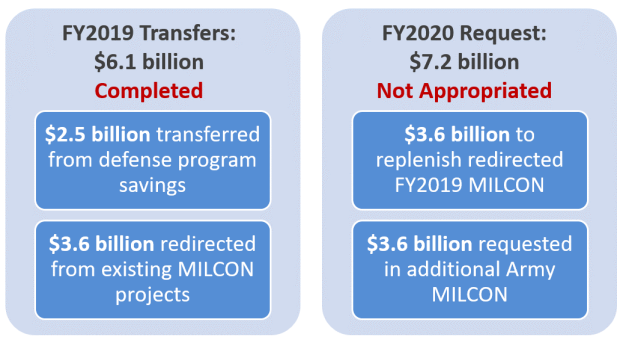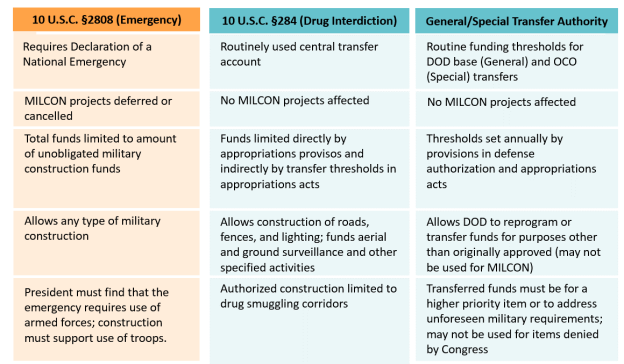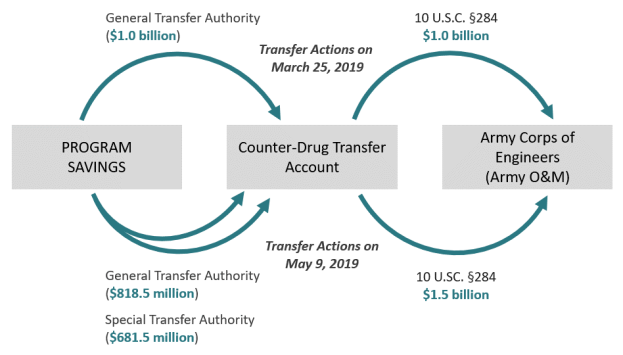Figure 1. Recent Border Barrier Funding Actions (Defense Only)

Source: CRS.
On January 13, 2020, the Washington Post reported that the Trump Administration plans to reallocate $7.2 billion in Department of Defense (DOD) appropriations to construct barriers along the U.S.-Mexico border. Of this amount, $3.7 billion would reportedly come from deferring congressionally approved military construction (MILCON) projects. An additional $3.5 billion would be redirected through DOD's Drug Interdiction and Counter-Drug Activities account (hereinafter counter-drug transfer account). If the Administration were to carry out the actions as described by the Washington Post, DOD would be using the same authorities it exercised in FY2019, when it transferred $6.1 billion in defense funds for border barriers. In this case, FY2019 and FY2020 defense funding for border barriers would total $13.3 billion.
On February 15, 2019, the Trump Administration announced plans for redirecting up to $6.1 billion from existing FY2019 DOD programs and projects to border wall construction, using a complex mix of emergency- and nonemergency-related authorities. These actions were challenged in litigation that remains ongoing.
During FY2020 budget deliberations, Congress considered a number of legislative provisions that would have constrained the Administration's use of similar authorities. These included provisions to
In late July 2019, congressional leadership announced they had come to an informal understanding, as part of a budget agreement that excluded "poison pills" and limited changes to transfer funding levels and authorities from annual appropriations measures.
Ultimately, Congress refrained from including legislative language in the FY2020 appropriations and authorization acts that would have reduced transfer thresholds or prohibited the Administration from repeating the transfer actions it had undertaken in FY2019 to support border barrier construction.
At the same time, Congress declined to support the Administration's FY2020 budget request to provide an additional $7.2 billion in MILCON appropriations. Of this amount, $3.6 billion would have replenished military construction projects depleted by emergency transfers in FY2019 and $3.6 billion would have directly supported additional border barrier construction.
|
Figure 1. Recent Border Barrier Funding Actions (Defense Only) |
 |
|
Source: CRS. |
In FY2019 the Administration redirected $6.1 billion from defense projects and programs using a combination of authorities (including 10 U.S.C. §2808 and 10 U.S.C. §284) that it could again employ using FY2020 appropriations. See Figure 2.
|
Figure 2. Comparison of Authorities Used in FY2019 to Transfer Defense Funds for Border Barrier Construction |
 |
|
Source: CRS graphic based on analysis of identified statutes. Notes: Emergency authority colored orange. Nonemergency colored blue. National emergencies may be terminated by Joint Resolution, subject to presidential veto. There are currently 34 national emergencies in effect. Drug smuggling corridors are not defined in law, but Customs and Border Protection considers the southern border to encompass in its entirety a series of drug smuggling corridors. Separate reprogramming authorities and processes are used for military construction appropriations. |
In FY2019, DOD reprogrammed $2.5 billion from a variety of nondrug defense programs into the counter-drug transfer account and then out to the U.S. Army Corps of Engineers (USACE) for border barrier construction.
The Administration relied on two authorities to reprogram funds into the counter-drug transfer account: the General Transfer Authority (for base appropriations) and the Special Transfer Authority (for overseas contingency operations, or OCO, appropriations). In turn, funds in the counter-drug transfer account may be used for a variety of counternarcotics activities, including those pursuant to 10 U.S.C. §284.
DOD used this combination of reprogramming and transfer actions twice in 2019: first in March ($1 billion) and again in May ($1.5 billion). See Figure 3.
|
Figure 3.How DOD Reprogrammed FY2019 Defense Program Savings |
 |
|
Source: Under Secretary of Defense (Comptroller), Reprogramming Action FY2019-01 RA (March 25, 2019) and FY2019-02 RA (May 9, 2019). |
When the President declares a national emergency requiring the use of the Armed Forces and invokes the emergency authority under 10 U.S.C. §2808, the Secretary of Defense is permitted to undertake construction projects "not otherwise authorized by law that are necessary to support such use of the armed forces." Such construction is funded using unobligated MILCON appropriations—effectively deferring previously approved MILCON projects until Congress provides replenishing appropriations.
DOD developed the following criteria to identify projects with unobligated balances it would not consider deferring under 10 U.S.C. §2808:
The Department's final selection indefinitely deferred 127 previously authorized MILCON projects. Figure 4 below shows the distribution by location.